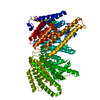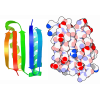[English] 日本語
 Yorodumi
Yorodumi- PDB-9exk: Scalable protein design using hallucination in a relaxed sequence... -
+ Open data
Open data
- Basic information
Basic information
| Entry | Database: PDB / ID: 9exk | |||||||||
|---|---|---|---|---|---|---|---|---|---|---|
| Title | Scalable protein design using hallucination in a relaxed sequence space | |||||||||
 Components Components | De novo designed protein K12 | |||||||||
 Keywords Keywords | DE NOVO PROTEIN / De novo designed protein K12 | |||||||||
| Biological species | synthetic construct (others) | |||||||||
| Method | ELECTRON MICROSCOPY / single particle reconstruction / cryo EM / Resolution: 3.36 Å | |||||||||
 Authors Authors | Frank, C.J. / Dietz, H. | |||||||||
| Funding support | European Union,  Germany, 2items Germany, 2items
| |||||||||
 Citation Citation |  Journal: Science / Year: 2024 Journal: Science / Year: 2024Title: Scalable protein design using optimization in a relaxed sequence space. Authors: Christopher Frank / Ali Khoshouei / Lara Fuβ / Dominik Schiwietz / Dominik Putz / Lara Weber / Zhixuan Zhao / Motoyuki Hattori / Shihao Feng / Yosta de Stigter / Sergey Ovchinnikov / Hendrik Dietz /    Abstract: Machine learning (ML)-based design approaches have advanced the field of de novo protein design, with diffusion-based generative methods increasingly dominating protein design pipelines. Here, we ...Machine learning (ML)-based design approaches have advanced the field of de novo protein design, with diffusion-based generative methods increasingly dominating protein design pipelines. Here, we report a "hallucination"-based protein design approach that functions in relaxed sequence space, enabling the efficient design of high-quality protein backbones over multiple scales and with broad scope of application without the need for any form of retraining. We experimentally produced and characterized more than 100 proteins. Three high-resolution crystal structures and two cryo-electron microscopy density maps of designed single-chain proteins comprising up to 1000 amino acids validate the accuracy of the method. Our pipeline can also be used to design synthetic protein-protein interactions, as validated experimentally by a set of protein heterodimers. Relaxed sequence optimization offers attractive performance with respect to designability, scope of applicability for different design problems, and scalability across protein sizes. | |||||||||
| History |
|
- Structure visualization
Structure visualization
| Structure viewer | Molecule:  Molmil Molmil Jmol/JSmol Jmol/JSmol |
|---|
- Downloads & links
Downloads & links
- Download
Download
| PDBx/mmCIF format |  9exk.cif.gz 9exk.cif.gz | 254.2 KB | Display |  PDBx/mmCIF format PDBx/mmCIF format |
|---|---|---|---|---|
| PDB format |  pdb9exk.ent.gz pdb9exk.ent.gz | 162.8 KB | Display |  PDB format PDB format |
| PDBx/mmJSON format |  9exk.json.gz 9exk.json.gz | Tree view |  PDBx/mmJSON format PDBx/mmJSON format | |
| Others |  Other downloads Other downloads |
-Validation report
| Summary document |  9exk_validation.pdf.gz 9exk_validation.pdf.gz | 1 MB | Display |  wwPDB validaton report wwPDB validaton report |
|---|---|---|---|---|
| Full document |  9exk_full_validation.pdf.gz 9exk_full_validation.pdf.gz | 1 MB | Display | |
| Data in XML |  9exk_validation.xml.gz 9exk_validation.xml.gz | 36.6 KB | Display | |
| Data in CIF |  9exk_validation.cif.gz 9exk_validation.cif.gz | 55.5 KB | Display | |
| Arichive directory |  https://data.pdbj.org/pub/pdb/validation_reports/ex/9exk https://data.pdbj.org/pub/pdb/validation_reports/ex/9exk ftp://data.pdbj.org/pub/pdb/validation_reports/ex/9exk ftp://data.pdbj.org/pub/pdb/validation_reports/ex/9exk | HTTPS FTP |
-Related structure data
| Related structure data |  50040MC  8s89C  8yl4C  8yl8C  9exzC  9f0lC M: map data used to model this data C: citing same article ( |
|---|
- Links
Links
- Assembly
Assembly
| Deposited unit | 
|
|---|---|
| 1 |
|
- Components
Components
| #1: Protein | Mass: 115735.977 Da / Num. of mol.: 1 Source method: isolated from a genetically manipulated source Source: (gene. exp.) synthetic construct (others) / Production host:  |
|---|---|
| Has protein modification | N |
-Experimental details
-Experiment
| Experiment | Method: ELECTRON MICROSCOPY |
|---|---|
| EM experiment | Aggregation state: PARTICLE / 3D reconstruction method: single particle reconstruction |
- Sample preparation
Sample preparation
| Component | Name: De Novo designed Protein K12 / Type: ORGANELLE OR CELLULAR COMPONENT / Entity ID: all / Source: RECOMBINANT |
|---|---|
| Molecular weight | Value: 0.114 MDa / Experimental value: NO |
| Source (natural) | Organism: synthetic construct (others) |
| Source (recombinant) | Organism:  |
| Buffer solution | pH: 7.4 / Details: Gibco PBS |
| Buffer component | Conc.: 0.4 mg/ml / Name: PBS / Formula: PBS |
| Specimen | Conc.: 3.6 mg/ml / Embedding applied: NO / Shadowing applied: NO / Staining applied: NO / Vitrification applied: YES |
| Vitrification | Cryogen name: ETHANE / Humidity: 95 % / Chamber temperature: 283 K |
- Electron microscopy imaging
Electron microscopy imaging
| Experimental equipment |  Model: Titan Krios / Image courtesy: FEI Company |
|---|---|
| Microscopy | Model: FEI TITAN KRIOS |
| Electron gun | Electron source:  FIELD EMISSION GUN / Accelerating voltage: 300 kV / Illumination mode: SPOT SCAN FIELD EMISSION GUN / Accelerating voltage: 300 kV / Illumination mode: SPOT SCAN |
| Electron lens | Mode: BRIGHT FIELD / Nominal magnification: 120000 X / Nominal defocus max: 3740 nm / Nominal defocus min: 100 nm / Cs: 2.7 mm |
| Image recording | Electron dose: 50 e/Å2 / Film or detector model: TFS FALCON 4i (4k x 4k) |
- Processing
Processing
| EM software | Name: PHENIX / Version: dev_5240 / Category: model refinement | ||||||||||||||||||||||||
|---|---|---|---|---|---|---|---|---|---|---|---|---|---|---|---|---|---|---|---|---|---|---|---|---|---|
| CTF correction | Type: PHASE FLIPPING AND AMPLITUDE CORRECTION | ||||||||||||||||||||||||
| 3D reconstruction | Resolution: 3.36 Å / Resolution method: FSC 0.143 CUT-OFF / Num. of particles: 451357 / Num. of class averages: 1 / Symmetry type: POINT | ||||||||||||||||||||||||
| Atomic model building | Protocol: FLEXIBLE FIT | ||||||||||||||||||||||||
| Atomic model building | Source name: AlphaFold / Type: in silico model | ||||||||||||||||||||||||
| Refinement | Cross valid method: NONE Stereochemistry target values: GeoStd + Monomer Library + CDL v1.2 | ||||||||||||||||||||||||
| Displacement parameters | Biso mean: 50.43 Å2 | ||||||||||||||||||||||||
| Refine LS restraints |
|
 Movie
Movie Controller
Controller



 PDBj
PDBj
